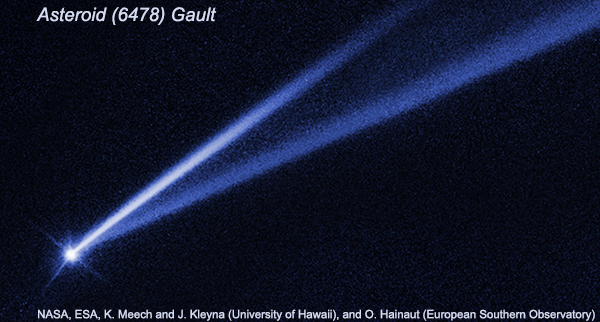Citation: Martel, L. M. V. (May, 2019) Active Asteroids, PSRD, http://www.psrd.hawaii.edu/May19/active-asteroids.html.
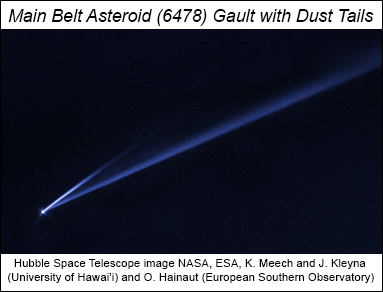
|
May 24, 2019
Active Asteroids
--- Researchers document the stunning effects of disintegrating asteroids to learn more about their dusty debris tails and the processes causing them to happen.
Written by Linda M. V. Martel
Hawai'i Institute of Geophysics and Planetology
Asteroids and comets have something in common, which is the release of constituent materials into space. This has not always been common knowledge. In fact, just 25 years ago a comet-like tail on an asteroid was unknown. Not until all-sky survey telescopes (such as Pan-STARRS, Catalina Sky Survey, ATLAS) and the high-resolution Hubble Space Telescope provided opportunities to discover and document the exquisite details of the temporary dust tails have we known that asteroids can actively shed mass.
An international team, using an array of data from ground-based telescopes and Hubble Space Telescope, has documented the stunning effects of a disintegrating main belt asteroid. Jan Kleyna (Institute for Astronomy, University of Hawai‘i) and colleagues from the US, Germany, Taiwan, UK, Italy, India, and The Netherlands observed asteroid (6478) Gault and two dust tails, which they attribute to two separate releases of dust from the rapidly-rotating, 4–10-kilometer-long asteroid. This detailed study and others, and new close-up observations of dust activity at asteroid Bennu by NASA's OSIRIS-REx mission offer insights not only into the ways dust is ejected, but also into asteroid evolution.
Reference:
- Kleyna, J. T., Hainaut, O. R., Meech, K. J., Hsieh, H. H., Fitzsimmons, A., Micheli, M., Keane, J. V., Denneau, L., Tonry, J., Heinze, A., Bhatt, B. C., Sahu, D. K., Koschny, D., Smith, K. W., Ebeling, H., Weryk, R., Flewelling, H., and Wainscoat, R. J. (2019) The Sporadic Activity of (6478) Gault: A YORP-driven Event? The Astrophysical Journal Letters, v. 874:L20, doi: 10.3847/2041-8213/ab0f40. [abstract]
- PSRDpresents: Active Asteroids -- Short Slide Summary (with accompanying notes).
What is an Active Asteroid?
The class of small Solar System bodies known as active asteroids is a fairly new construct arising from the wealth of data provided by all-sky survey telescopes, the NASA/ESA Hubble Space Telescope, and robotic spacecraft missions to asteroids. In the book Asteroids IV published in 2015, authors David Jewitt (UCLA), Henry Hsieh (Academia Sinica, now with the Planetary Science Institute), and Jessica Agarwal (Max Planck Institute for Solar System Research) define an active asteroid as "ejecting dust, producing transient, comet-like comae and tails." Active asteroids have typical orbits for asteroids—mainly within the main asteroid belt. The first description of a comet-like tail on a body orbiting in the main asteroid belt, named 133P/Elst-Pizarro, came in 1996 from data from the European Southern Observatory (see the report in the International Astronomical Union Circular). In 2006 after the discovery of two more such objects in the outer main belt, Hsieh and Jewitt identified this new population of bodies by initially calling them "main-belt comets." But active asteroids need not be icy. Today researchers refer to a subset of active asteroids as main-belt comets specifically when they determine the recurring activity is due to sublimation of near-surface ice. We'll discuss more about the variety of processes potentially driving the activity of active asteroids in the next section.
Whatever the cause of the dust release, whether or not a tail is observed depends on many factors, including particle size, brightness, telescope observing conditions, instrument-measurement sensitivity, or having a spacecraft in the right place at the right time. The number of known active asteroids described in the 2015 book Asteroids IV was 18, with researchers predicting that many more existed. As of mid-2019, the number of observed active asteroids is already around 30, with the Hawai‘i-based Panoramic Survey Telescope and Rapid Response System (Pan-STARRS) leading the number of new discoveries. By observing the asteroids and their debris tails (before they fade away), astronomers and cosmochemists gather data about composition (e.g. volatiles) and the nature of the destructive or disruptive activity, which can help explain what causes the activity.
Main Belt Asteroid (6478) Gault
Dust activity at asteroid (6478) Gault was first detected on January 5, 2019 when a dust tail was unexpectedly identified in data collected by the NASA-funded ATLAS sky survey. ATLAS stands for the Asteroid Terrestrial-Impact Last Alert System. Follow-up observations by Jan Kleyna and colleagues, including with the Hubble Space Telescope in 2019, confirmed two dust tails (see image below).
Asteroid Gault's dust tails are attributed to separate releases of material from the fast-rotating, 4–10-kilometer-long asteroid. For the dust tail observed in January, 2019, the ATLAS team searched archived data and found that it first appeared on December 8, 2018, which matches a dust-discharge date in late October of the same year according to modeling results. This dust tail persisted for about two weeks. They determined that another dust release in late December produced the second dust tail seen in the Hubble image, which lasted several days.
Researchers hypothesize that this type of mass-loss may be attributed to impact disruption, sublimation of subsurface ices, YORP spin-up, or a combination of mechanisms. Regarding YORP spin-up, astronomers described it well in a Hubble news release, "When sunlight heats an asteroid, infrared radiation escaping from its warmed surface carries off momentum as well as heat. This process creates a tiny torque that can cause the asteroid to continually spin faster. When the resulting centrifugal force starts to overcome gravity, the asteroid's surface becomes unstable, and landslides may send dust and rubble drifting into space at a couple miles per hour, or the speed of a strolling human." In the case of asteroid (6478) Gault, now spinning about its axis once every two hours, Jan Kleyna and coauthors suggest enough tiny dust particles cascaded and drifted off the asteroid into space to be swept away by solar-radiation pressure to create the debris tails. At the same time, in separate research using light curve data from ZTF (Zwicky Transient Facility, Palomar Observatory in California), Quanzhi Ye (CalTech) and coauthors reached a similar conclusion, that dust was ejected during rotational disruption or a YORP-driven merger of two close bodies.
Robotic Spacecraft to Active Asteroids
Active asteroids that have been or will be visited by robotic spacecraft are few: Ceres, Phaethon, Ryugu, and Bennu. It won't be long before samples are returned to Earth from Ryugu and Bennu by current missions.
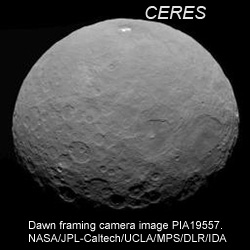 |
(1) Ceres (~950-kilometers-diameter asteroid redesignated in 2006 as a dwarf planet, but still included here because it's cool) |
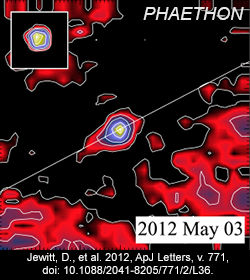 |
(3200) Phaethon (~5-kilometers-diameter parent body of Geminid meteor shower) |
 |
(162173) Ryugu (~900-meters-diameter asteroid) |
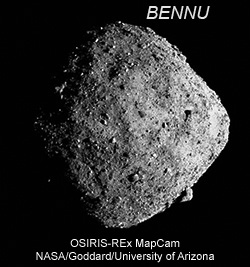 |
(101955) Bennu (~500-meters-diameter asteroid) |
Appreciating Asteroids
No longer is there a sharp difference between comets and asteroids. Now we have seen asteroids actively ejecting rocks or sporting sporadic dust tails. How rare are active asteroids? How icy could some really be? Continued studies of the details of dust tails will provide answers as scientists scout for new asteroid activity or reactivation. If, for instance, the dust activity is determined to be sublimation of ice, then researchers, such as David Jewitt (UCLA) and co-workers who studied asteroid P/2017 S5, say we should see tails appearing again at the active asteroid's next perihelion. Finding more icy small bodies is intriguing as they factor into hypotheses as potential impact-delivery systems of water to early Earth, but that's a complex issue! (See PSRD articles: The Complicated Origin of Earth's Water and Water, Carbonaceous Chondrites, and Earth.) From ejections of surface dust and centimeter-sized rocks that orbit and drop back down, to the formation of dust tails, we have many reasons to appreciate active asteroids and to anticipate future robotic spacecraft missions to them.
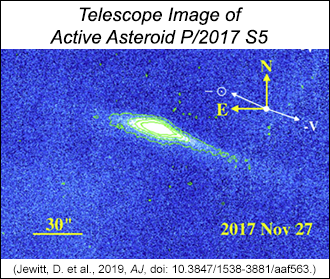 |
Asteroid P/2017 S5 with tail, as imaged by the WIYN telescope at Kitt Peak National Observatory, Arizona. |
- PSRDpresents: Active Asteroids --Short Slide Summary (with accompanying notes).
- ATLAS — Asteroid Terrestrial-impact Last Alert System website.
- Chandler, C. O., Curtis, A. M., Mommert, M., Sheppard, S. S., and Trujillo, C. A. (2018) SAFARI: Searching Asteroids for Activity Revealing Indicators, Publications of the Astronomical Society of the Pacific, v. 130:114502, doi: 10.1088/1538-3873/aad03d. [abstract]
- Hsieh, H. H., Denneau, L., Wainscoat, R. J., Schörghofer, N., Bolin, B., Fitzsimmons, A., Jedicke, R., Kleyna, J., Micheli, M., Veres, P., Kaiser, N., Chambers, K. C., Burgett, W. S., Flewelling, H., Hodapp, K. W., Magnier, E. A., Morgan, J. S., Price, P. A., Tonry, J. L., and Waters, C. (2015) The Main-belt Comets: The Pan-STARRS1 Perspective, Icarus, v. 248, p. 289-312, doi: 10.1016/j.icarus.2014.10.031. [abstract]
- Hsieh, H. H. and Jewitt, D. (2006) A Population of Comets in the Main Asteroid Belt, Science, v. 312, p. 561-563, doi: 10.1126/science.1125150. [abstract]
- Hubble Watches Spun-up Asteroid Coming Apart NASA News item.
- Ito, T., Ishiguro, M., Arai, T., Imai, M., Sekiguchi, T., Bach, Y. P., Kwon, Y. G., Kobayashi, M., Ishimaru, R., Naito, H., Watanabe, M., and Kuramoto, K. (2018) Extremely Strong Polarization of an Active Asteroid (3200) Phaethon, Nature Communications, v. 9:2486, doi: 10.1038/s41467-018-04727-2. [article]
- Jewitt, D., Kim, Y., Rajagopal, J., Ridgway, S., Kotulla, R., Liu, W., Mutchler, M., Li, J., Weaver, H., and Larson, S. (2019) Active Asteroid P/2017 S5 (ATLAS), The Astronomical Journal, v. 157:45, doi: 10.3847/1538-3881/aaf563. [abstract]
- Jewitt, D., Agarwal, J., Weaver, H., Mutchler, M., and Larson, S. (2013) The Extraordinary Multi-tailed Main-belt Comet P/2013 P5, The Astrophysical Journal Letters, v. 778:L21, doi: 10.1088/2041-8205/778/1/L21. [article]
- Jewitt, D., Li, J., and Agarwal, J. (2013) The Dusttail of Asteroid (3200) Phaethon, The Astrophysical Journal Letters, v. 771:L36, doi: 10.1088/2041-8205/771/2/L36. [article]
- Kleyna, J. T., Hainaut, O. R., Meech, K. J., Hsieh, H. H., Fitzsimmons, A., Micheli, M., Keane, J. V., Denneau, L., Tonry, J., Heinze, A., Bhatt, B. C., Sahu, D. K., Koschny, D., Smith, K. W., Ebeling, H., Weryk, R., Flewelling, H., and Wainscoat, R. J. (2019) The Sporadic Activity of (6478) Gault: A YORP-driven Event? The Astrophysical Journal Letters, v. 874:L20, doi: 10.3847/2041-8213/ab0f40. [abstract]
- Lauretta, D. S., DellaGiustina, D. N., the OSIRIS-REx Team, et al. (2019) The Unexpected Surface of Asteroid (101955) Bennu, Nature, v. 568, pl 55-60, doi: 10.1038/s41586-019-1033-6. [abstract]
- Martel, L. M. V. (April 2018) Icarus Journal—Special Issue on Asteroids and Space Debris, PSRD. www.psrd.hawaii.edu/CosmoSparks/April18/Icarus-v304.html.
- Michel, P., DeMeo, F. E., and Bottke, W. F. (Eds.). (2015) Asteroids IV. Tucson: University of Arizona Press. [book]
- PanSTARRS — Panoramic Survey Telescope and Rapid Response System online public data archive.
- Ye, Q., Kelley, M. S. P., Bodewits, D., Bolin, B., Jones, L., Lin, Z.-Y., Bellm, E. C., Dekany, R., Duev, D. A., Groom, S., Helou, G., Kulkarni, S. R., Kupfer, T., Masci, F. J., Prince, T. A., and Soumagnac, M. T. (2019) Multiple Outbursts of Asteroid (6478) Gault, The Astrophysical Journal Letters, v. 874:L16, doi: 10.3847/2041-8213/ab0f3c. [paper]
|
|
[ About PSRD | Archive | CosmoSparks | Search | Subscribe ] [ Glossary | General Resources | Comments | Top of page ] |

